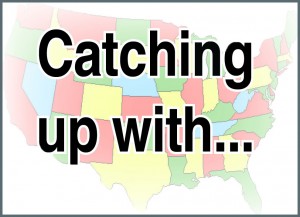Curtis Clough
State Administrator—Career and Technical Education
Department of Education and Early Development
Alaska
How did you come to be the State CTE Director in your state?
I am new to the state of Alaska as of October 2014 coming from the state of Ohio as superintendent of Strasburg Franklin Local Schools. Over the last eight years I have experienced Career Technical Education (CTE) through both secondary and postsecondary settings, as a superintendent and in my role as Academic Chair for Mohave Community College-Neal Campus in Kingman, Arizona where I oversaw both academic and CTE programs. With over 25 years of experience in education, I have progressed to the state level to assist in advancing educational opportunities for all students and engaging our partners in a process that prepares individuals at all levels for career readiness so people can be active members of the workforce and society.
What are your major goals for CTE in your state?
The state of Alaska has several goals for the upcoming years for CTE. First, the state is engaging in a dialogue on the “level of expectations†for all students in exemplar programs and courses that align to industry needs and standards. A cross-pathway approach is being discussed that establishes some minimal level of performance in reading, writing and math as well as in technical and employability skills, such as technology and problem solving, that prepares students beyond high school graduation and can be addressed through curriculum and work-based learning.
In addition, the state is exploring ways to deliver programming to our rural districts so all students have access to quality CTE programs that are aligned to industry standards and credentials. This is being done by looking at professional development models for our teachers and administrators as well as content delivery models including online instruction so students have access to a blended model of coursework and real-work experiences.
Finally, aligning pathways across secondary and postsecondary systems is another major goal of ours, with the inclusion of apprenticeships, internships and other work-based learning opportunities. We want to create a multi-entry system across all levels of education so that future employees are meeting the workforce development needs of Alaska and our priority industries and occupations.
What do you think your biggest challenges are in your new role as State CTE Director?
Incorporating CTE into the school day is quite a struggle for our districts because of the costs and associated graduation requirements that hinder flexibility in schedules for students. This made more challenging because of our current budget crunch that is occurring because of the decline in oil prices. Districts have limited resources for CTE programming in this tight financial climate and are being asked to do more with less funding.
Also, creating standardized expectations for academic and technical skills across pathways is going to be a challenge because of the geography of Alaska. With unique local needs as well as the needs of the state, expectations can be very different. For example, welding is a growing need in our state, but many regions choose to focus their programs on local industries like maritime, construction or oil and gas processes. Setting that minimum level of expectation for students is difficult due to the distinct regional and local needs.
Finally, teacher recruitment and sustaining a professional development model for our teachers and administrators are other potential issues as the staff turnover and attrition in our rural districts is high. If an educator or administrator has received the proper training and opportunity for advancement in CTE, he or she may move on to bigger opportunities in our urban areas or move to another district that offers more options career-wise. This is a continuous issue for the state and developing strategies to address this problem are being considered at this time.
What do you think the future of CTE looks like in your state?
The opportunity for CTE in our state is bright. The “We3†partners – the Department of Education and Early Development, Department of Labor and Workforce Development and the University of Alaska – have been working collaboratively on addressing the points of the State CTE Plan and many of the issues stated above. Currently, these partners have been working together to establish “levels of expectations†for students for workforce readiness, as we implement the Workforce Investment and Opportunity Act (WIOA). As part of this process, the partners engage in bi-weekly meetings to review various aspects of the WIOA requirements and how to best align WIOA and the State CTE Plan, which is currently in progress, so CTE can continue to expand and grow the Alaska workforce at all levels.
Also, due to the aging workforce and there is a catalyst for industry and postsecondary partners to work together to meet the needs of our future workforce. Active discussions are taking place outside the normal channels in cross-sector strategy meetings, with representation from the “We3†partners so all avenues and opportunities are explored and strategies developed with partner input that can be sustained for the years to come in Alaska.
Katie Fitzgerald, Communications AssociateÂ


